Characteristics of Fracturing Fluid Invasion Layer and Its Influence on Gas Production of Shale Gas Reservoirs
Abstract
1. Introduction
2. Experimental Study
2.1. Experiment Samples
2.2. Experimental Equipment and Procedures
- CT scanning was performed on two dry core samples before the water invasion experiment.
- The two core samples were placed respectively in the core holder, and the confining pressure was increased to 50 MPa by the hand piston pump and the water was increased to 40 MPa by the ISCO pump, and then water began to invade the two shale core samples.
- After 24 h of water intrusion into the core samples, the ISCO pump pressure was removed first, and then the piston pump pressure was removed. The two core samples were taken out, and the surface moisture of the samples was wiped dry for the CT scan.
- Steps (2) and (3) were repeated to obtain the CT scanning results of the shale core samples with a water intrusion time of 2 days, 4 days, and 6 days, respectively.
- After CT scanning, the data were imported into Avizo software, and the core samples in different blocks and at different water invasion times were reconstructed in three dimensions, respectively, to obtain the scanning images of each section of the core sample to identify the pores and fractures.
2.3. Experimental Results and Discussion
3. Numerical Simulations
3.1. Numerical Model
3.2. Effect of Permeability of FFIL on Pressure and Gas Production
3.3. Effect of Thickness of FFIL on Pressure and Gas Production
4. Discussion
5. Conclusions
- The water invasion experiment confirmed that the retained fracturing fluid would induce microfracture propagation in the matrix, and the law and distance of fracture propagation were related to the original physical properties of the shale sample and the time of water invasion.
- The shale samples used in the experiment are relatively dense with very low porosity and permeability, and the water intrusion thickness obtained at the core sample scale is only centimeter-level. However, it can be seen from the dimensionless water intrusion thickness that 15~45% of the core samples are affected by water intrusion.
- Compared with a shallow shale reservoir, a deep shale reservoir has a denser matrix and lower permeability, so the penetration depth of fracturing fluid is smaller, the thickness of the fracturing fluid invasion layer is smaller, and fracture propagation is more difficult.
- For shale gas wells, the positive and negative effects of fracturing fluid retention on the reservoir usually coexist, and dimensionless fracturing fluid invasion layer permeability was introduced to characterize the relative magnitude of the two effects. The higher the dimensionless fracturing fluid invasion layer permeability, the more complex the fracture network formed after fracturing will be, resulting in a longer stable production period, a higher cumulative gas production, and a better development effect.
- Dimensionless fracturing fluid invasion layer thickness was introduced to characterize the depth of fracturing fluid intrusion into the matrix. For low-permeability rock samples, the positive effect of fracturing fluid retention is greater, and the rock sample’s permeability becomes higher than its initial permeability. In this case, the larger the dimensionless fracturing fluid invasion layer thickness, the more the fracturing fluid retained in the reservoir is used to form microfractures; and the larger the propagation range of the microfractures, the longer the stable production period, the greater the cumulative gas production, and the better the development effect will be.
- The key to the efficient development of shale gas wells is to optimize the soaking time and flowback speed in combination with reservoir characteristics and fracture development, in order to maximize the positive effects and minimize the negative effects of fracturing fluid retention, and to extend the stable production period.
Author Contributions
Funding
Data Availability Statement
Conflicts of Interest
References
- Zou, C.; Zhao, Q.; Cong, L. Development progress, potential and prospect of shale gas in China. Nat. Gas. Ind. 2021, 41, 1–14. [Google Scholar]
- Zhang, L.; He, X.; Li, X. Shale gas exploration and development in the Sichuan Basin: Progress, challenge and countermeasures. Nat. Gas. Ind. 2021, 41, 143–152. [Google Scholar] [CrossRef]
- Warpinski, N.; Kramm, R.; Heinze, J. Comparison of single- and dual-array microseismic mapping techniques in the Barnett Shale. In Proceedings of the SPE Annual Technical Conference and Exhibition, Dallas, TX, USA, 9–12 October 2005; Available online: https://onepetro.org/SEGAM/proceedings/SEG05/All-SEG05/SEG-2005-1261/93122 (accessed on 6 April 2023).
- Palisch, T.; Vincent, M.; Handren, P. Slickwater Fracturing: Food for Thought. SPE Prod. Oper. 2010, 25, 327–344. [Google Scholar] [CrossRef]
- Javadpour, F.; Fisher, D.; Unsworth, M. Nanoscale Gas Flow in Shale Gas Sediments. J. Can. Pet. Technol. 2007, 46, 55–61. [Google Scholar] [CrossRef]
- Wilson, A. Chemical Analysis of Flowback Water and Downhole Gas-Shale Samples. J. Pet. Technol. 2016, 68, 114–115. [Google Scholar] [CrossRef]
- Ghanbari, E.; Abbasi, M.; Dehghanpour, H. Flowback volumetric and chemical analysis for evaluating load recovery and its impact on early-time production. In Proceedings of the SPE Unconventional Resources Conference Canada, Calgary, AL, Canada, 5–7 November 2013. [Google Scholar] [CrossRef]
- Clarkson, C.; Williams-Kovacs, J. Modeling Two-Phase Flowback of Multifractur ed Horizontal Wells Completed in Shale. SPE J. 2013, 18, 795–812. [Google Scholar] [CrossRef]
- Shaoul, J.; Van Zelm, L.; De Pater, C. Damage Mechanisms in Unconventional-Gas-Well Stimulation—A New Look at an Old Problem. SPE Prod. Oper. 2011, 26, 388–400. [Google Scholar]
- Huang, Z. Research on Mechanisms of Retention and Flowback of Fracturing Fluids in Artificial Fracture Network. Master’s Thesis, China University of Petroleum, Beijing, China, 2019. [Google Scholar]
- Song, B. Model for Fracturing Fluid Flowback and Characterization of Flowback Mechanisms. Ph.D. Thesis, Texas A & M University, College Station, TX, USA, 2014. Available online: https://oaktrust.library.tamu.edu/bitstream/handle/1969.1/153854/SONG-DISSERTATION-2014.pdf (accessed on 6 April 2023).
- McClure, M. The potential effect of network complexity on recovery of injected fluid following hydraulic fracturing. In Proceedings of the SPE Unconventional Resources Conference, The Woodlands, TX, USA, 1–3 April 2014. [Google Scholar] [CrossRef]
- Agrawal, S.; Sharma, M. Liquid loading within hydraulic fractures and its impact on unconventional reservoir productivity. In Proceedings of the Unconventional Resources Technology Conference, Denver, CO, USA, 12–14 August 2013. [Google Scholar] [CrossRef]
- Parmar, J.; Dehghanpour, H.; Kuru, E. Displacement of water by gas in propped fractures: Combined effects of gravity, surface tension, and wettability. J. Unconv. Oil Gas Resour 2014, 5, 10–21. [Google Scholar] [CrossRef]
- Liu, Y. Modeling of Recovery and In-situ Distribution of Fracturing Fluid in Shale Gas Reservoirs Due to Fracture Closure, Proppant Distribution and Gravity Segregation. Master’s Thesis, University of Alberta, Edmonton, AL, Canada, 2017. [Google Scholar] [CrossRef]
- Parmar, J.; Dehghanpour, H.; Kuru, E. Drainage Against Gravity: Factors Impacting the Load Recovery in Fractures. In Proceedings of the SPE Unconventional Resources Conference-USA, The Woodlands, TX, USA, 10–12 April 2013. [Google Scholar] [CrossRef]
- Cheng, Y. Impact of Water Dynamics in Fractures on the Performance of Hydraulically Fractured Wells in Gas-Shale Reservoirs. J. Can. Pet. Technol. 2012, 51, 143–151. [Google Scholar] [CrossRef]
- Penny, G.; Pursley, J.; Clawson, T. Field Study of Completion Fluids to Enhance Gas Production in the Barnett Shale. In Proceedings of the SPE Gas Technology Symposium, Calgary, AL, Canada, 15–17 May 2006. [Google Scholar] [CrossRef]
- King, G. Thirty years of gas shale fracturing: What have we learned? In Proceedings of the SPE Annual Technical Conference and Exhibition, Florence, Italy, 19–22 September 2010. [Google Scholar] [CrossRef]
- Warpinski, N.; Mayerhofer, M.; Vincent, M. Stimulating Unconventional Reservoirs: Maximizing Network Growth While Optimizing Fracture Conductivity. J. Can. Pet. Technol. 2009, 48, 39–51. [Google Scholar] [CrossRef]
- McClure, M.; Horne, R. Correlations between formation properties and induced seismicity during high pressure injection into granitic rock. Eng. Geol. 2014, 175, 74–80. [Google Scholar] [CrossRef]
- Modeland, N.; Buller, D.; Chong, K. Statistical analysis of the effect of completion methodology on production in the Haynesville Shale. In Proceedings of the North American Unconventional Gas Conference and Exhibition, The Woodlands, TX, USA, 14–16 June 2011. [Google Scholar] [CrossRef]
- Chang, L. Study on Interaction Mechanism between Unsaturated Shale with Fractures and Fluid. Ph.D. Thesis, China University of Petroleum, Beijing, China, 2019. [Google Scholar] [CrossRef]
- Dehghanpour, H.; Lan, Q.; Saeed, Y. Spontaneous Imbibition of Brine and Oil in Gas Shales: Effect of Water Adsorption and Resulting Microfractures. Eng. Fuels 2013, 27, 3039–3049. [Google Scholar] [CrossRef]
- Roshan, H.; Ehsani, S.; Marjo, C. Mechanisms of water adsorption into partially saturated fractured shales: An experimental study. Fuel 2015, 159, 628–637. [Google Scholar] [CrossRef]
- Meng, M.; Ge, H.; Ji, W. Investigation on the variation of shale permeability with spontaneous imbibition time: Sandstones and volcanic rocks as comparative study. J. Nat. Gas Sci. Eng. 2015, 27, 1546–1554. [Google Scholar] [CrossRef]
- Meng, M.; Ge, H.; Ji, W. Research on the auto-removal mechanism of shale aqueous phase trapping using low field nuclear magnetic resonance technique. J. Petrol. Sci. Eng. 2016, 137, 63–73. [Google Scholar] [CrossRef]
- Lv, F. Interacions between shale reservoir and fracturing fluid in Southern Sichuan. Master’s Thesis, China University of Petroleum (East China), Qingdao, China, 2019. [Google Scholar] [CrossRef]
- Liu, Y.; Leung, J.; Chalaturnyk, R. New Insights on Mechanisms Controlling Fracturing-Fluid Distribution and Their Effects on Well Performance in Shale-Gas Reservoirs. SPE Prod. Oper. 2019, 34, 564–585. [Google Scholar] [CrossRef]
- Kang, Y.; Zhang, X.; You, L. The experimental research on spontaneous flowbackrelieving aqueous phase trapping damage in shale gas reservoirs. Nat. Gas. Geosci. 2017, 28, 819–827. [Google Scholar]
- Zhou, T.; Zhang, S.; Yang, L. Experimental investigation on fracture surface strength softening induced by fracturing fluid imbibition and its impacts on flow conductivity in shale reservoirs. J. Nat. Gas Sci. Eng. 2016, 36, 893–905. [Google Scholar] [CrossRef]
- Zhou, Z.; Teklu, T.; Li, X. Experimental study of the osmotic effect on shale matrix imbibition process in gas reservoirs. J. Nat. Gas Sci. Eng. 2018, 49, 1–7. [Google Scholar] [CrossRef]
- Liu, X.; Xiong, J.; Liang, L. Hydration Experiment of Hard Brittle Shale of the Longmaxi Formation. J. Southwest Petrol. Univ. Nat. Sci. Ed. 2016, 38, 178–186. [Google Scholar]
- Zhang, J.; Zhu, D.; Hill, A. Water-induced fracture conductivity damage in shale formations. In Proceedings of the SPE Hydraulic Fracturing Technology Conference, The Woodlands, TX, USA, 3–5 February 2015. [Google Scholar] [CrossRef]
- Rouchaudhuri, B.; Tsotsis, T.; Jessen, K. Shale-fluid interactions during forced lmbibition and flow-back. J. Petrol. Sci. Eng. 2019, 172, 443–453. [Google Scholar] [CrossRef]
- Singh, H. A critical review of water uptake by shales. J. Nat. Gas. Sci. Eng. 2016, 34, 751–766. [Google Scholar] [CrossRef]
- You, L.; Cheng, Q.; Kang, Y. Experimental study on spontaneous water imbibition in fracture networks of shale rocks. J. China Univ. Pet. Nat. Sci. Ed. 2016, 38, 178–186. [Google Scholar]
- Wu, Y.; Cheng, L.; Ma, L. A transient two-phase flow model for production prediction of tight gas wells with fracturing fluid-induced formation damage. J. Petrol. Sci. Eng. 2021, 199, 108351. [Google Scholar] [CrossRef]
- Zhao, Z.; He, Y.; Guo, J.; Zheng, X.; Tao, L.; Deng, X. Experimental Study on the Forcible Imbibition Law of Water in Shale Gas Reservoirs. Processes 2023, 11, 1057. [Google Scholar] [CrossRef]
- Xu, L.; Huang, S.; Sun, M.; Wen, Y.; Chen, W.; Zhang, Y.; Luo, F.; Zhang, H. Palaeoenvironmental Evolution Based on Elemental Geochemistry of the Wufeng-Longmaxi Shales in Western Hubei, Middle Yangtze, China. Minerals 2023, 13, 502. [Google Scholar] [CrossRef]
- Jin, Z.; Johnson, S.E.; Fan, Z.Q. Subcritical propagation and coalescence of oil-filled cracks: Getting the oil out of lowpermeability source rocks. Geophys. Res. Lett. 2010, 37, L01305. [Google Scholar] [CrossRef]
- Fan, Z.; Jin, Z.; Johnson, S. Modelling petroleum migration through microcrack propagation in transversely isotropic source rocks. Geophys. J. Int. 2012, 190, 179–187. [Google Scholar] [CrossRef]
- Makarova, A.; Kaliberda, I.; Kovalev, D. Modeling a production well flow control system using the example of the Verkhneberezovskaya Area. In Proceedings of the 2022 Conference of Russian Young Researchers in Electrical and Electronic Engineering (ElConRus), Saint Petersburg, Russia, 25–28 January 2022. [Google Scholar] [CrossRef]
- Makarova, A.; Mantorova, I.; Kovalev, D. The modeling of mineral water fields data structure. In Proceedings of the 2021 IEEE Conference of Russian Young Researchers in Electrical and Electronic Engineering (ElConRus), Saint Petersburg/Moscow, Russia, 26–29 January 2021. [Google Scholar] [CrossRef]
- Martirosyan, A.; Ilyushin, Y. Modeling of the Natural Objects’ Temperature Field Distribution Using a Supercomputer. Informatics 2022, 9, 62. [Google Scholar] [CrossRef]
- Lyons Cerón, A.; Konist, A. Co-Pyrolysis of Woody Biomass and Oil Shale in a Batch Reactor in CO2, CO2-H2O, and Ar Atmospheres. Energies 2023, 16, 3145. [Google Scholar] [CrossRef]
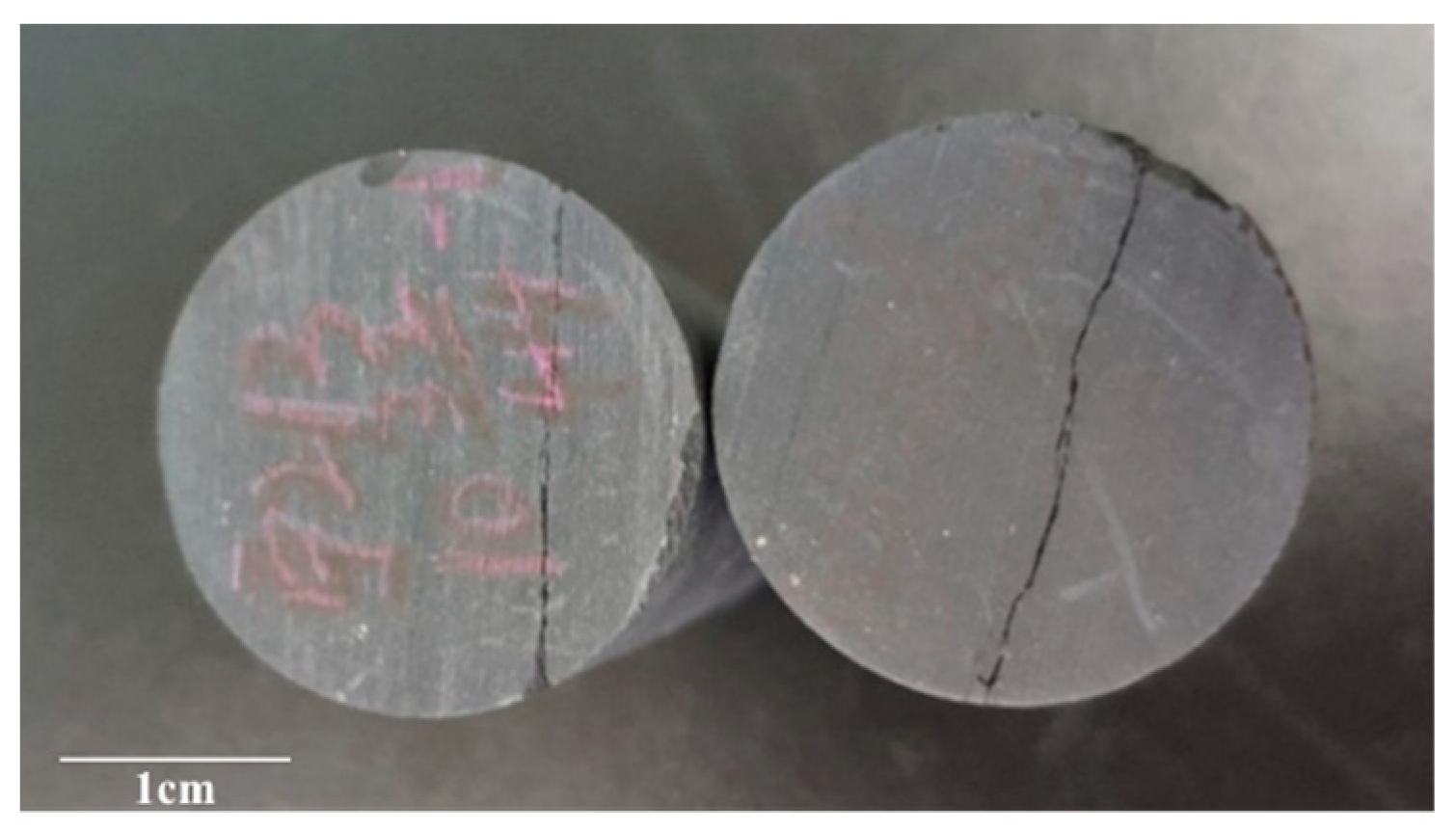


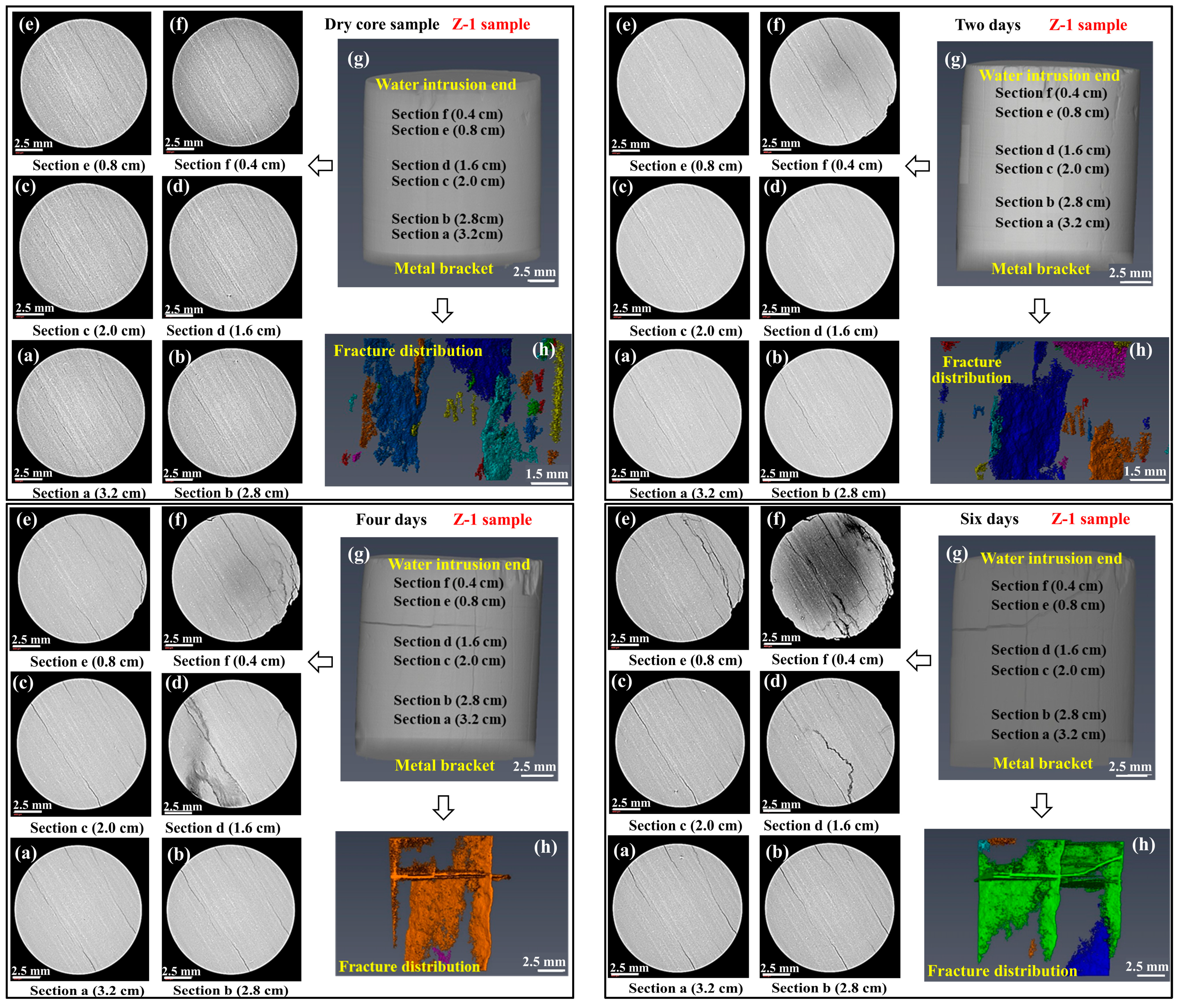
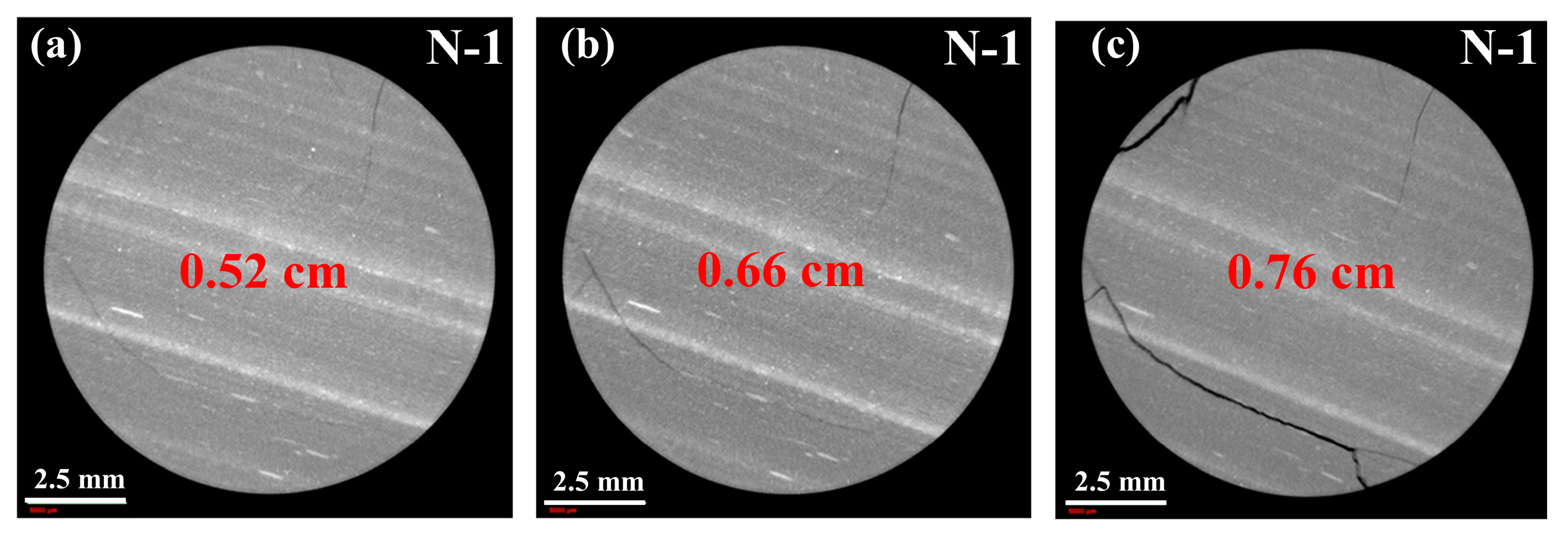
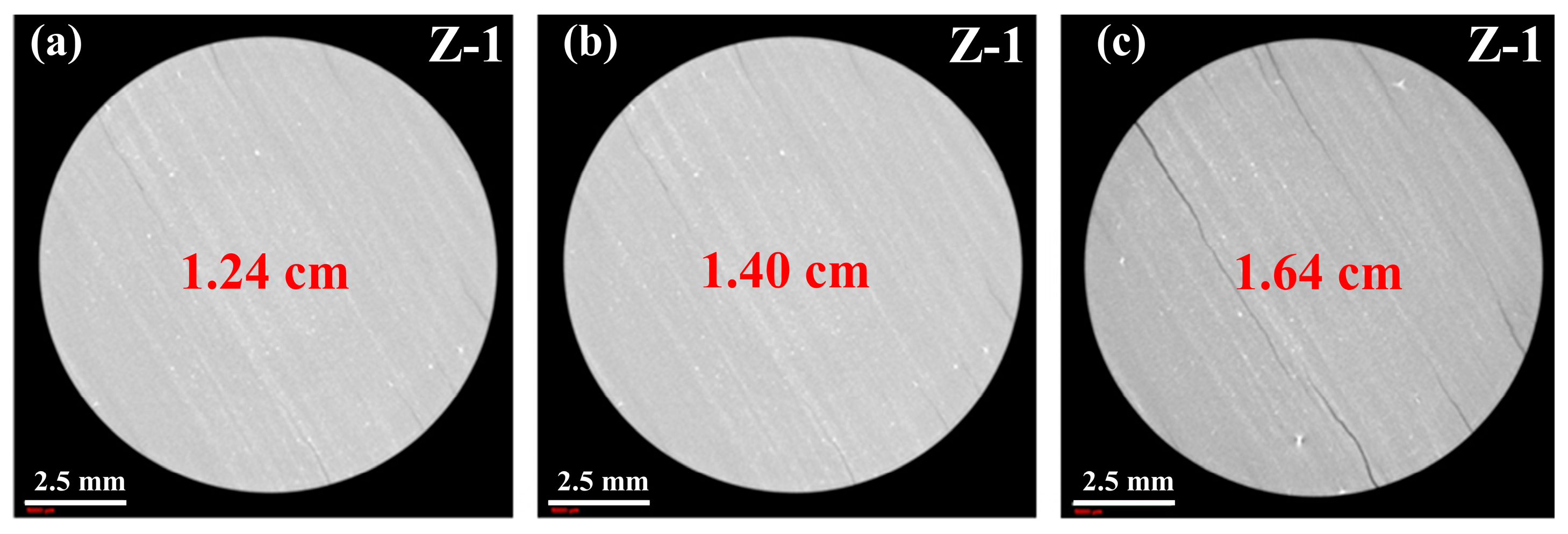



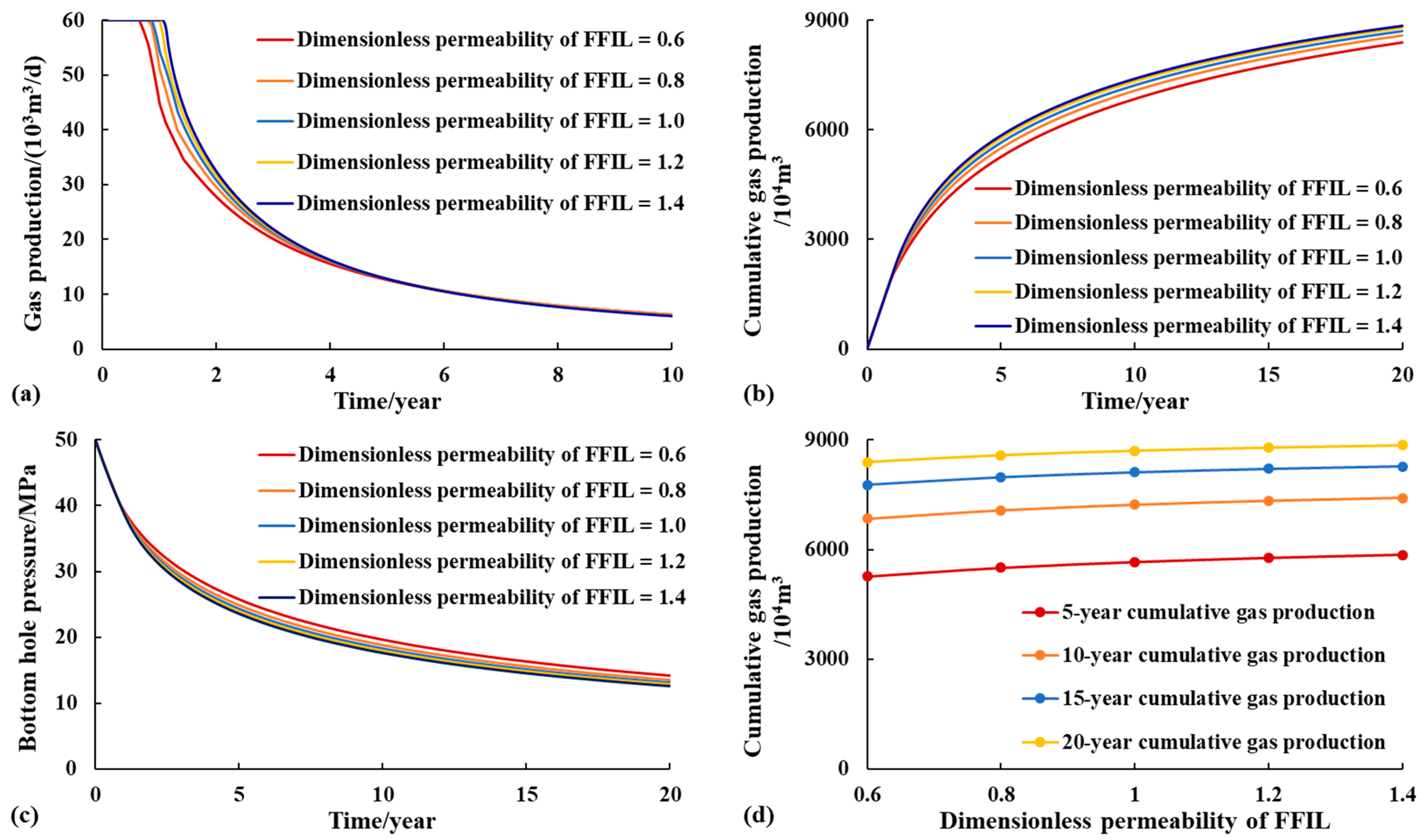


| Samples | Depth (m) | Porosity (%) | Diameter (cm) | Length (cm) | Dry Weight (g) | Density (kg/m3) |
|---|---|---|---|---|---|---|
| N-1 | 3925 | 2.56 | 2.502 | 3.603 | 44.547 | 2.516 |
| Z-1 | 3384 | 4.07 | 2.521 | 3.641 | 46.881 | 2.581 |
| Parameters | Values | Parameters | Values |
|---|---|---|---|
| Initial formation pressure/MPa | 50 | Gas saturation/% | 70 |
| Initial formation temperature/K | 373.15 | Formation thickness/m | 38 |
| Permeability of matrix/10−3μm2 | 0.0005 | Compression coefficient/MPa−1 | 3 × 10−3 |
| Porosity/% | 5 | Shale density/(g/cm3) | 2.6 |
| Half-length of fracture/m | 120 | Langmuir volume/(m3/t) | 3 |
| Conductivity of fracture/(mD·m) | 5 | Langmuir pressure/MPa | 6.5 |
Disclaimer/Publisher’s Note: The statements, opinions and data contained in all publications are solely those of the individual author(s) and contributor(s) and not of MDPI and/or the editor(s). MDPI and/or the editor(s) disclaim responsibility for any injury to people or property resulting from any ideas, methods, instructions or products referred to in the content. |
© 2023 by the authors. Licensee MDPI, Basel, Switzerland. This article is an open access article distributed under the terms and conditions of the Creative Commons Attribution (CC BY) license (https://creativecommons.org/licenses/by/4.0/).
Share and Cite
Huang, S.; Zhang, J.; Shi, J.; Zhao, F.; Duan, X. Characteristics of Fracturing Fluid Invasion Layer and Its Influence on Gas Production of Shale Gas Reservoirs. Energies 2023, 16, 3924. https://doi.org/10.3390/en16093924
Huang S, Zhang J, Shi J, Zhao F, Duan X. Characteristics of Fracturing Fluid Invasion Layer and Its Influence on Gas Production of Shale Gas Reservoirs. Energies. 2023; 16(9):3924. https://doi.org/10.3390/en16093924
Chicago/Turabian StyleHuang, Shijun, Jiaojiao Zhang, Jin Shi, Fenglan Zhao, and Xianggang Duan. 2023. "Characteristics of Fracturing Fluid Invasion Layer and Its Influence on Gas Production of Shale Gas Reservoirs" Energies 16, no. 9: 3924. https://doi.org/10.3390/en16093924
APA StyleHuang, S., Zhang, J., Shi, J., Zhao, F., & Duan, X. (2023). Characteristics of Fracturing Fluid Invasion Layer and Its Influence on Gas Production of Shale Gas Reservoirs. Energies, 16(9), 3924. https://doi.org/10.3390/en16093924





